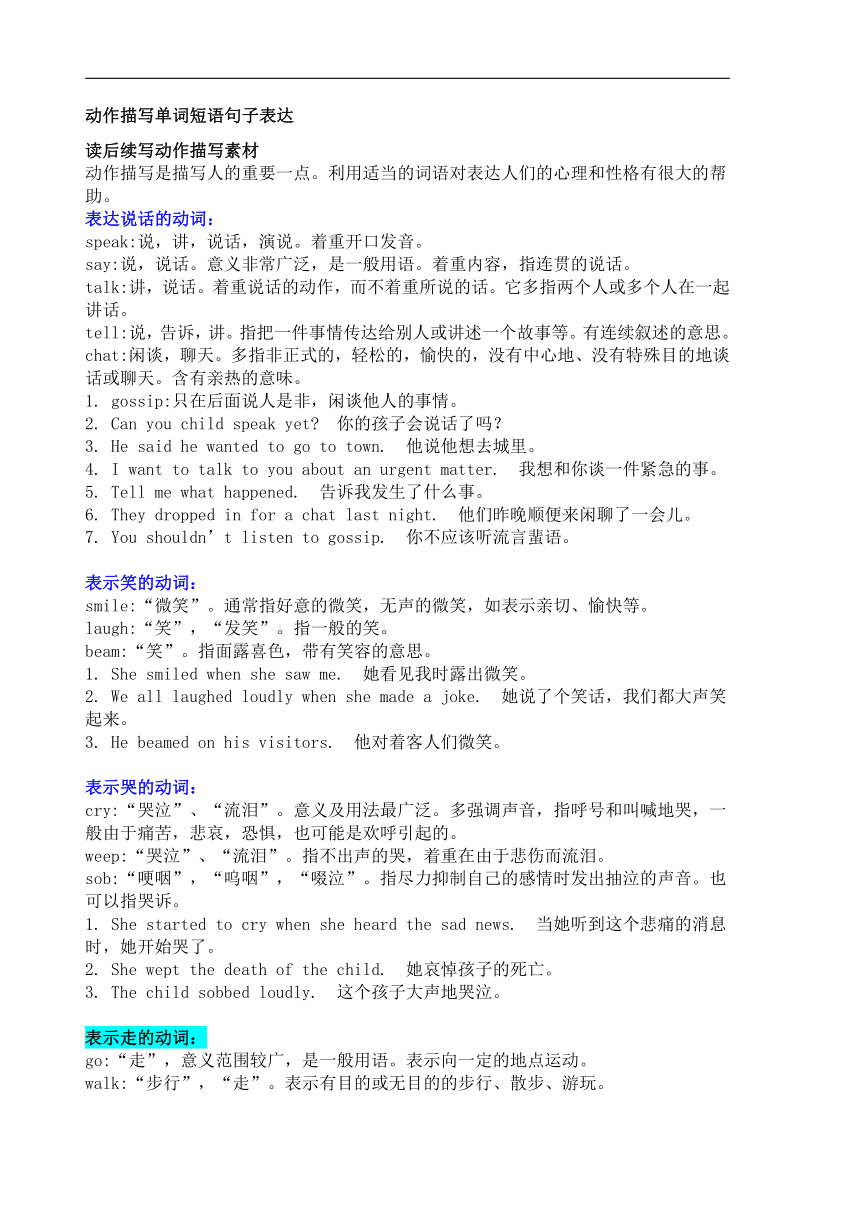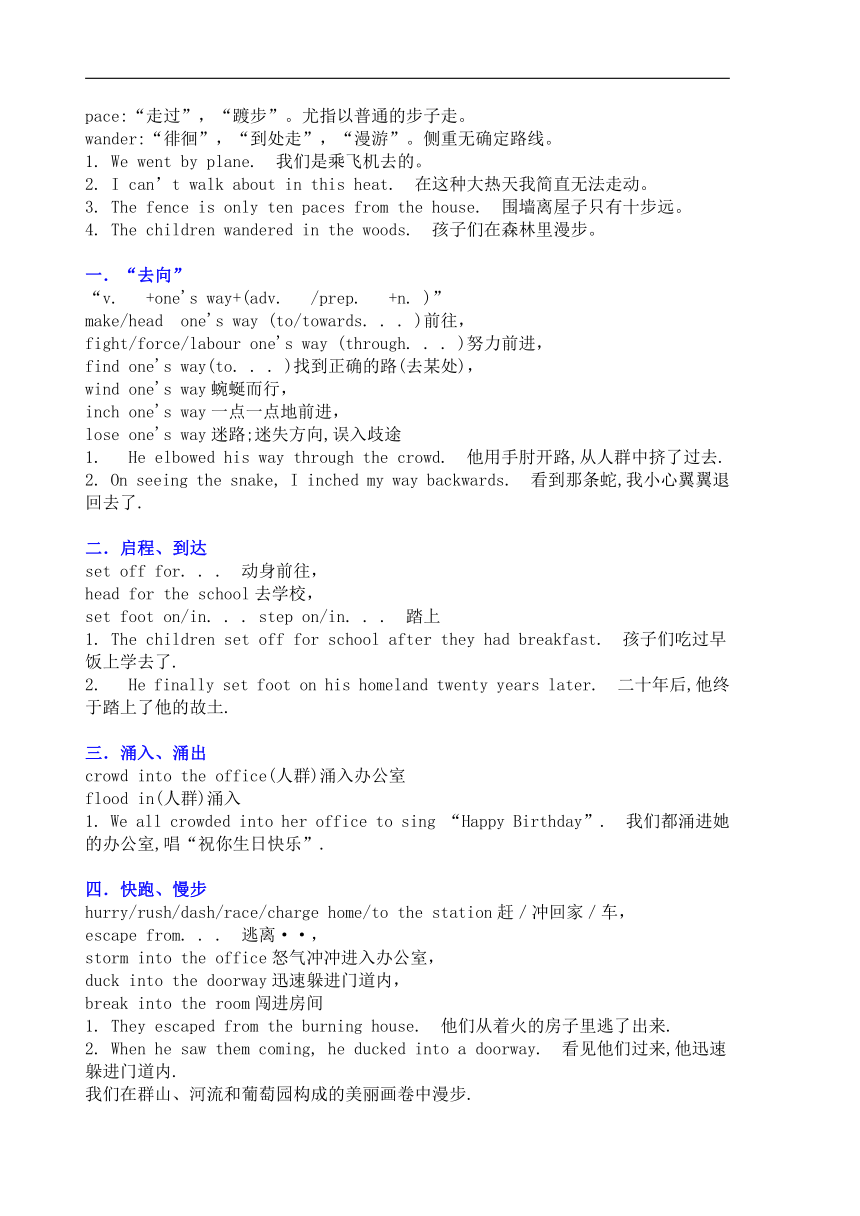2024届高三英语二轮复习动作描写单词短语句子表达 清单-
文档属性
| 名称 | 2024届高三英语二轮复习动作描写单词短语句子表达 清单- |  | |
| 格式 | docx | ||
| 文件大小 | 25.3KB | ||
| 资源类型 | 教案 | ||
| 版本资源 | 通用版 | ||
| 科目 | 英语 | ||
| 更新时间 | 2024-04-04 10:10:46 | ||
图片预览


文档简介
动作描写单词短语句子表达
读后续写动作描写素材
动作描写是描写人的重要一点。利用适当的词语对表达人们的心理和性格有很大的帮助。
表达说话的动词:
speak:说,讲,说话,演说。着重开口发音。
say:说,说话。意义非常广泛,是一般用语。着重内容,指连贯的说话。
talk:讲,说话。着重说话的动作,而不着重所说的话。它多指两个人或多个人在一起讲话。
tell:说,告诉,讲。指把一件事情传达给别人或讲述一个故事等。有连续叙述的意思。
chat:闲谈,聊天。多指非正式的,轻松的,愉快的,没有中心地、没有特殊目的地谈话或聊天。含有亲热的意味。
1. gossip:只在后面说人是非,闲谈他人的事情。
2. Can you child speak yet 你的孩子会说话了吗?
3. He said he wanted to go to town. 他说他想去城里。
4. I want to talk to you about an urgent matter. 我想和你谈一件紧急的事。
5. Tell me what happened. 告诉我发生了什么事。
6. They dropped in for a chat last night. 他们昨晚顺便来闲聊了一会儿。
7. You shouldn’t listen to gossip. 你不应该听流言蜚语。
表示笑的动词:
smile:“微笑”。通常指好意的微笑,无声的微笑,如表示亲切、愉快等。
laugh:“笑”,“发笑”。指一般的笑。
beam:“笑”。指面露喜色,带有笑容的意思。
1. She smiled when she saw me. 她看见我时露出微笑。
2. We all laughed loudly when she made a joke. 她说了个笑话,我们都大声笑起来。
3. He beamed on his visitors. 他对着客人们微笑。
表示哭的动词:
cry:“哭泣”、“流泪”。意义及用法最广泛。多强调声音,指呼号和叫喊地哭,一般由于痛苦,悲哀,恐惧,也可能是欢呼引起的。
weep:“哭泣”、“流泪”。指不出声的哭,着重在由于悲伤而流泪。
sob:“哽咽”,“呜咽”,“啜泣”。指尽力抑制自己的感情时发出抽泣的声音。也可以指哭诉。
1. She started to cry when she heard the sad news. 当她听到这个悲痛的消息时,她开始哭了。
2. She wept the death of the child. 她哀悼孩子的死亡。
3. The child sobbed loudly. 这个孩子大声地哭泣。
表示走的动词:
go:“走”,意义范围较广,是一般用语。表示向一定的地点运动。
walk:“步行”,“走”。表示有目的或无目的的步行、散步、游玩。
pace:“走过”,“踱步”。尤指以普通的步子走。
wander:“徘徊”,“到处走”,“漫游”。侧重无确定路线。
1. We went by plane. 我们是乘飞机去的。
2. I can’t walk about in this heat. 在这种大热天我简直无法走动。
3. The fence is only ten paces from the house. 围墙离屋子只有十步远。
4. The children wandered in the woods. 孩子们在森林里漫步。
一.“去向”
“v. +one's way+(adv. /prep. +n. )”
make/head one's way (to/towards. . . )前往,
fight/force/labour one's way (through. . . )努力前进,
find one's way(to. . . )找到正确的路(去某处),
wind one's way蜿蜒而行,
inch one's way一点一点地前进,
lose one's way迷路;迷失方向,误入歧途
1. He elbowed his way through the crowd. 他用手肘开路,从人群中挤了过去.
2. On seeing the snake, I inched my way backwards. 看到那条蛇,我小心翼翼退回去了.
二.启程、到达
set off for. . . 动身前往,
head for the school去学校,
set foot on/in. . . step on/in. . . 踏上
1. The children set off for school after they had breakfast. 孩子们吃过早饭上学去了.
2. He finally set foot on his homeland twenty years later. 二十年后,他终于踏上了他的故土.
三.涌入、涌出
crowd into the office(人群)涌入办公室
flood in(人群)涌入
1. We all crowded into her office to sing “Happy Birthday”. 我们都涌进她的办公室,唱“祝你生日快乐”.
四.快跑、慢步
hurry/rush/dash/race/charge home/to the station赶/冲回家/车,
escape from. . . 逃离··,
storm into the office怒气冲冲进入办公室,
duck into the doorway迅速躲进门道内,
break into the room闯进房间
1. They escaped from the burning house. 他们从着火的房子里逃了出来.
2. When he saw them coming, he ducked into a doorway. 看见他们过来,他迅速躲进门道内.
我们在群山、河流和葡萄园构成的美丽画卷中漫步.
3.He dashed out of the room, his heart pounding with excitement.(他感到兴奋,心脏砰砰直跳,他冲出房间。)
五.步态轻盈、跌跌撞撞
dance off down the road蹦蹦跳跳沿着马路走
mount the steps登上台阶
1. He danced off down the road. 他蹦蹦跳跳地沿着马路走了.
2. She mounted the steps slowly but firmly. 她慢慢地但坚定地迈上台阶.
3.With a graceful leap, she landed lightly on her feet.(以优雅的跳跃,她轻巧地着地了。)
六.趾高气扬、蹑手蹑脚
sweep out of the room大模大样地走出房间,
creep up the stairs/upstairs蹑手蹑脚地上了楼,
track down. . . 跟踪······
1. I crept up the stairs, trying not to wake my parents. 为了尽量不吵醒父母,我蹑手蹑脚地上了楼.
2. We tracked down the spy to his quarters. 我们跟踪那个间谍,一直跟到他的老巢.
七.坐、跪、摔、爬、站、跃、移、转
bend/crouch over/down弯腰;俯身;屈膝 step on sb. 's foot踩到······的脚
go down on one's knees(双膝)跪下 crawl on one's hands and knees手脚并用爬
struggle to one's feet挣扎着站起来 pick oneself up振作精神
1. He said nothing but bend down to pick it up personally. 什么也没有说,就自己弯腰捡起它.
2. He stumbled on the uneven ground and fell flat on his face. 他在不平的地上绊了一跤,摔了个嘴啃泥.
3. He staggered in and dropped into a chair. 他蹒跚着走进来,一屁股坐在椅子上.
4. She backed up a few steps. 她后退了几步.
八.“手”相关的动作
“打”:beat, hit, strike, knock, tap, touch, clap, applaud, burst into applause, slap,
1. As he finished the speech, the audience burst into applause. 当他结束演讲,观众席响起雷鸣般的掌声.
2. I slapped him hard across the face. 我重重地掴了他一记耳光.
九.“抓”:
catch, hold (hold on to. . . ),grasp, seize, grab, snatch, rob, scratch, arrest, capture, reach for·. . ,slip from one's grasp
1. I jumped up to catch/ seize/grasp a ball and fell over. 我跳起来接球,结果摔了个跟头.
2. The thief suddenly grabbed/snatched the purse from her and escaped. 小偷猛地一把夺过她的钱包逃跑了.
十.“揽/抱”:
throw one's arms around . . . , gather, scoop ,hug, embrace, put a protective arm around . . .
1. I ran up and threw my arms around him. 我跑上前去,张开双臂搂住他.
2. She gathered/scooped the child in her arms/to her and held him close. 她把孩子拉过来紧紧抱在怀里.
十一.“拉”;
pull, draw, drag
1. She pulled him gently towards her. 她把他轻轻地拉到身边.
2. Gathering all his strength, he dragged her to the front door. 他使出全身的力气把她拖到前门.
十二.“举”:
raise, lift, put up one's hands, throw up one's hands
1. He raised his hand to wave. 他举手挥动起来.
2. He lifted his hand to knock on the door. 他抬手敲门.
十三.“捡”:
collect, gather, accumulate, pile up, pick, pick up
1. Let's pile up the fallen leaves in the corner . 我们把落叶堆到角落里.
2. She picked up her bag, and went on her way. 她提起包继续赶路.
十四.手部动作
push推、press/squeeze挤、tear撕、point at指、fold折、tie扎、wrap解、Cover盖、dress穿、undress脱、wave挥、throw扔、dig挖、rub擦、fill填、pour倒、shake摇
1. She tied/untie her scarf over her head. 她把头巾围在头上/解开围巾.
2. She shrugged and spread her hands. “That's all I can tell you. ”她耸耸肩,摊开双手说:“我只能告诉你这么多了. ”
十五.“头、脸”相关的动作
1.The student scratched his head before answering the question. 那位学生回答问题前挠了挠头.
2.We were covered from head to foot(从头到脚;遍布全身)in mud. 我们浑身是泥.
3. With a gentle shake of her head, she refused his offer. (她轻轻地摇摇头,拒绝了他的提议。)
4.With a triumphant toss of his head, he announced his victory to the crowd. (他得意地扬了扬头,向人群宣布了他的胜利。)
5.With a nod of agreement, he signaled his approval of the new plan. (他点了点头表示同意,表达了对新计划的认可。)
6. Cocking his head to the side, he listened intently to the distant sound of music. (他把头歪向一边,全神贯注地聆听着远处的音乐声。)
7. With a slow nod of comprehension, she finally understood the complex concept. (她缓缓地点了点头表示理解,终于明白了那个复杂的概念。)
十六.“眼”相关的动作
glance at匆匆一瞥
glare at 怒视
stare at盯着看
1. Her eyes sparkled/danced with happiness. 她的双眼闪耀着幸福的光芒.
2. She was blinking her eyes rapidly. 她快速地眨了眨眼.
3. I scanned the crowd, searching for Tom. 我扫视人群,寻找汤姆.
十七.“耳、鼻、口”相关的动作
1. She'll smile from ear to ear if we give her a bike for her birthday.
如果我们送她一辆自行车作为生日礼物,她会笑得合不拢嘴.
2. She blew her nose as daintily as possible. 她尽量文雅地擤了擤鼻涕.
3. I am out of breath, let me took a deep breath. . 我上气不接下气,让我深深地吸口气.
十八. “doing. . . (动作伴随)” “动作伴随”之“with十宾语十宾补”
1. The children ran out of the room, laughing and talking merrily. 孩子们跑出房间,快乐地说笑着.
2. Moms are right there with their sleeves rolled up. 妈妈们在那儿撸起袖子加油干.
读后续写动作描写素材
动作描写是描写人的重要一点。利用适当的词语对表达人们的心理和性格有很大的帮助。
表达说话的动词:
speak:说,讲,说话,演说。着重开口发音。
say:说,说话。意义非常广泛,是一般用语。着重内容,指连贯的说话。
talk:讲,说话。着重说话的动作,而不着重所说的话。它多指两个人或多个人在一起讲话。
tell:说,告诉,讲。指把一件事情传达给别人或讲述一个故事等。有连续叙述的意思。
chat:闲谈,聊天。多指非正式的,轻松的,愉快的,没有中心地、没有特殊目的地谈话或聊天。含有亲热的意味。
1. gossip:只在后面说人是非,闲谈他人的事情。
2. Can you child speak yet 你的孩子会说话了吗?
3. He said he wanted to go to town. 他说他想去城里。
4. I want to talk to you about an urgent matter. 我想和你谈一件紧急的事。
5. Tell me what happened. 告诉我发生了什么事。
6. They dropped in for a chat last night. 他们昨晚顺便来闲聊了一会儿。
7. You shouldn’t listen to gossip. 你不应该听流言蜚语。
表示笑的动词:
smile:“微笑”。通常指好意的微笑,无声的微笑,如表示亲切、愉快等。
laugh:“笑”,“发笑”。指一般的笑。
beam:“笑”。指面露喜色,带有笑容的意思。
1. She smiled when she saw me. 她看见我时露出微笑。
2. We all laughed loudly when she made a joke. 她说了个笑话,我们都大声笑起来。
3. He beamed on his visitors. 他对着客人们微笑。
表示哭的动词:
cry:“哭泣”、“流泪”。意义及用法最广泛。多强调声音,指呼号和叫喊地哭,一般由于痛苦,悲哀,恐惧,也可能是欢呼引起的。
weep:“哭泣”、“流泪”。指不出声的哭,着重在由于悲伤而流泪。
sob:“哽咽”,“呜咽”,“啜泣”。指尽力抑制自己的感情时发出抽泣的声音。也可以指哭诉。
1. She started to cry when she heard the sad news. 当她听到这个悲痛的消息时,她开始哭了。
2. She wept the death of the child. 她哀悼孩子的死亡。
3. The child sobbed loudly. 这个孩子大声地哭泣。
表示走的动词:
go:“走”,意义范围较广,是一般用语。表示向一定的地点运动。
walk:“步行”,“走”。表示有目的或无目的的步行、散步、游玩。
pace:“走过”,“踱步”。尤指以普通的步子走。
wander:“徘徊”,“到处走”,“漫游”。侧重无确定路线。
1. We went by plane. 我们是乘飞机去的。
2. I can’t walk about in this heat. 在这种大热天我简直无法走动。
3. The fence is only ten paces from the house. 围墙离屋子只有十步远。
4. The children wandered in the woods. 孩子们在森林里漫步。
一.“去向”
“v. +one's way+(adv. /prep. +n. )”
make/head one's way (to/towards. . . )前往,
fight/force/labour one's way (through. . . )努力前进,
find one's way(to. . . )找到正确的路(去某处),
wind one's way蜿蜒而行,
inch one's way一点一点地前进,
lose one's way迷路;迷失方向,误入歧途
1. He elbowed his way through the crowd. 他用手肘开路,从人群中挤了过去.
2. On seeing the snake, I inched my way backwards. 看到那条蛇,我小心翼翼退回去了.
二.启程、到达
set off for. . . 动身前往,
head for the school去学校,
set foot on/in. . . step on/in. . . 踏上
1. The children set off for school after they had breakfast. 孩子们吃过早饭上学去了.
2. He finally set foot on his homeland twenty years later. 二十年后,他终于踏上了他的故土.
三.涌入、涌出
crowd into the office(人群)涌入办公室
flood in(人群)涌入
1. We all crowded into her office to sing “Happy Birthday”. 我们都涌进她的办公室,唱“祝你生日快乐”.
四.快跑、慢步
hurry/rush/dash/race/charge home/to the station赶/冲回家/车,
escape from. . . 逃离··,
storm into the office怒气冲冲进入办公室,
duck into the doorway迅速躲进门道内,
break into the room闯进房间
1. They escaped from the burning house. 他们从着火的房子里逃了出来.
2. When he saw them coming, he ducked into a doorway. 看见他们过来,他迅速躲进门道内.
我们在群山、河流和葡萄园构成的美丽画卷中漫步.
3.He dashed out of the room, his heart pounding with excitement.(他感到兴奋,心脏砰砰直跳,他冲出房间。)
五.步态轻盈、跌跌撞撞
dance off down the road蹦蹦跳跳沿着马路走
mount the steps登上台阶
1. He danced off down the road. 他蹦蹦跳跳地沿着马路走了.
2. She mounted the steps slowly but firmly. 她慢慢地但坚定地迈上台阶.
3.With a graceful leap, she landed lightly on her feet.(以优雅的跳跃,她轻巧地着地了。)
六.趾高气扬、蹑手蹑脚
sweep out of the room大模大样地走出房间,
creep up the stairs/upstairs蹑手蹑脚地上了楼,
track down. . . 跟踪······
1. I crept up the stairs, trying not to wake my parents. 为了尽量不吵醒父母,我蹑手蹑脚地上了楼.
2. We tracked down the spy to his quarters. 我们跟踪那个间谍,一直跟到他的老巢.
七.坐、跪、摔、爬、站、跃、移、转
bend/crouch over/down弯腰;俯身;屈膝 step on sb. 's foot踩到······的脚
go down on one's knees(双膝)跪下 crawl on one's hands and knees手脚并用爬
struggle to one's feet挣扎着站起来 pick oneself up振作精神
1. He said nothing but bend down to pick it up personally. 什么也没有说,就自己弯腰捡起它.
2. He stumbled on the uneven ground and fell flat on his face. 他在不平的地上绊了一跤,摔了个嘴啃泥.
3. He staggered in and dropped into a chair. 他蹒跚着走进来,一屁股坐在椅子上.
4. She backed up a few steps. 她后退了几步.
八.“手”相关的动作
“打”:beat, hit, strike, knock, tap, touch, clap, applaud, burst into applause, slap,
1. As he finished the speech, the audience burst into applause. 当他结束演讲,观众席响起雷鸣般的掌声.
2. I slapped him hard across the face. 我重重地掴了他一记耳光.
九.“抓”:
catch, hold (hold on to. . . ),grasp, seize, grab, snatch, rob, scratch, arrest, capture, reach for·. . ,slip from one's grasp
1. I jumped up to catch/ seize/grasp a ball and fell over. 我跳起来接球,结果摔了个跟头.
2. The thief suddenly grabbed/snatched the purse from her and escaped. 小偷猛地一把夺过她的钱包逃跑了.
十.“揽/抱”:
throw one's arms around . . . , gather, scoop ,hug, embrace, put a protective arm around . . .
1. I ran up and threw my arms around him. 我跑上前去,张开双臂搂住他.
2. She gathered/scooped the child in her arms/to her and held him close. 她把孩子拉过来紧紧抱在怀里.
十一.“拉”;
pull, draw, drag
1. She pulled him gently towards her. 她把他轻轻地拉到身边.
2. Gathering all his strength, he dragged her to the front door. 他使出全身的力气把她拖到前门.
十二.“举”:
raise, lift, put up one's hands, throw up one's hands
1. He raised his hand to wave. 他举手挥动起来.
2. He lifted his hand to knock on the door. 他抬手敲门.
十三.“捡”:
collect, gather, accumulate, pile up, pick, pick up
1. Let's pile up the fallen leaves in the corner . 我们把落叶堆到角落里.
2. She picked up her bag, and went on her way. 她提起包继续赶路.
十四.手部动作
push推、press/squeeze挤、tear撕、point at指、fold折、tie扎、wrap解、Cover盖、dress穿、undress脱、wave挥、throw扔、dig挖、rub擦、fill填、pour倒、shake摇
1. She tied/untie her scarf over her head. 她把头巾围在头上/解开围巾.
2. She shrugged and spread her hands. “That's all I can tell you. ”她耸耸肩,摊开双手说:“我只能告诉你这么多了. ”
十五.“头、脸”相关的动作
1.The student scratched his head before answering the question. 那位学生回答问题前挠了挠头.
2.We were covered from head to foot(从头到脚;遍布全身)in mud. 我们浑身是泥.
3. With a gentle shake of her head, she refused his offer. (她轻轻地摇摇头,拒绝了他的提议。)
4.With a triumphant toss of his head, he announced his victory to the crowd. (他得意地扬了扬头,向人群宣布了他的胜利。)
5.With a nod of agreement, he signaled his approval of the new plan. (他点了点头表示同意,表达了对新计划的认可。)
6. Cocking his head to the side, he listened intently to the distant sound of music. (他把头歪向一边,全神贯注地聆听着远处的音乐声。)
7. With a slow nod of comprehension, she finally understood the complex concept. (她缓缓地点了点头表示理解,终于明白了那个复杂的概念。)
十六.“眼”相关的动作
glance at匆匆一瞥
glare at 怒视
stare at盯着看
1. Her eyes sparkled/danced with happiness. 她的双眼闪耀着幸福的光芒.
2. She was blinking her eyes rapidly. 她快速地眨了眨眼.
3. I scanned the crowd, searching for Tom. 我扫视人群,寻找汤姆.
十七.“耳、鼻、口”相关的动作
1. She'll smile from ear to ear if we give her a bike for her birthday.
如果我们送她一辆自行车作为生日礼物,她会笑得合不拢嘴.
2. She blew her nose as daintily as possible. 她尽量文雅地擤了擤鼻涕.
3. I am out of breath, let me took a deep breath. . 我上气不接下气,让我深深地吸口气.
十八. “doing. . . (动作伴随)” “动作伴随”之“with十宾语十宾补”
1. The children ran out of the room, laughing and talking merrily. 孩子们跑出房间,快乐地说笑着.
2. Moms are right there with their sleeves rolled up. 妈妈们在那儿撸起袖子加油干.
